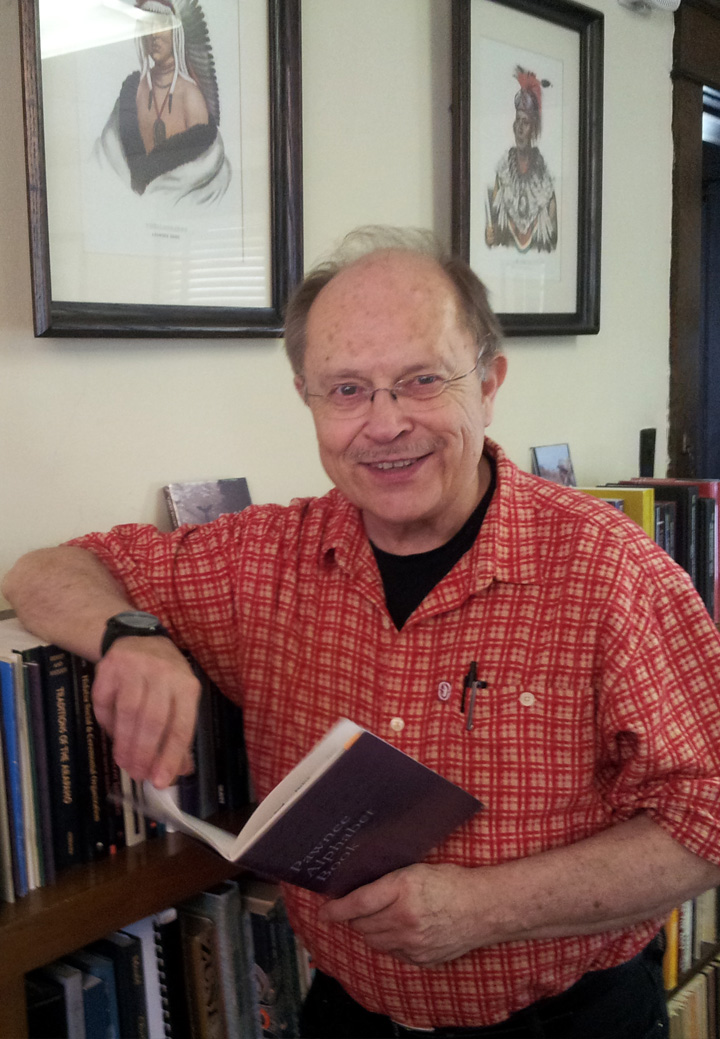- Campus:
- IU Bloomington

Douglas Parks’ training was in anthropological linguistics at the University of California-Berkeley. There, under the influence of Mary R. Haas, student of Edward Sapir, he developed a lifelong commitment to the documentation of North American Indian languages. The ultimate goal of his work was to contribute to the reconstruction of American Indian culture history generally, but the focus of it was the study of the languages of the Great Plains, particularly the Caddoan and Siouan peoples. His first field work was in Oklahoma during the late 1960s. Then, after living for a decade in the northern Plains region, where he helped develop language retention programs on the Fort Berthold Indian Reservation in North Dakota, Parks came to Indiana University in 1983 to help found the American Indian Studies Research Institute, which was established to perpetuate studies in American Indian cultures, languages, and history.
A large part of his career was devoted to the documentation of two Northern Caddoan languages, both endangered and spoken now by only a small number of elders: Pawnee (located in Oklahoma) and Arikara (located in North Dakota). This documentary work, which extended over thirty years, culminated in dictionaries, collections of native language texts, and grammars of these languages.
In an ongoing collaboration with Raymond J. DeMallie, Parks studied the dialectal diversity of the Sioux, Assiniboine, and Stoney peoples on numerous reservations throughout the Northern Plains. An important part of that project is a documentary study of the Assiniboine language, itself dialectally diverse, that will ultimately result in linguistic reference works. A related project that he undertook is the compilation of a dictionary of Yanktonai, a Sioux dialect that has never been adequately documented.
An outgrowth of these documentary efforts was his work with language retention and maintenance programs. In North Dakota, beginning in 1975, he helped establish programs for teaching three languages, Arikara, Mandan, and Hidatsa. His own work focused on Arikara, which is currently being taught in the White Shield School (Fort Berthold Reservation). He worked with a team to revise older language curricula and develop new teaching materials in multimedia format for students at both the elementary and secondary levels. He also collaborated with the Pawnee tribe to develop similar materials for teaching Pawnee.
Another dimension of his career is native North American philology, the study of older linguistic records of American Indian languages, and the combination of American Indian language research with the writing and interpretation of history. The documentary record on American Indians is replete with native language material that requires identification, translation, and interpretation. It is a rich source of information on North American history and prehistory that has only recently come to be appreciated by scholars. Applying knowledge of American Indian languages to these documents unlocks their potential for study of the American Indian past. Exemplifying this effort is an edition that Parks prepared of the journals of the Saint Louis fur trader, Jean-Baptiste Truteau, who lived among the Arikara in 1795. The editorial work on these manuscripts required a firm grounding in the Arikara language as well as a comparative knowledge of Plains Indian ethnology and history.
A fundamental part of Parks’ study of endangered languages and North American culture history was the recording, editing, and translating of native language texts, both those recorded from contemporary raconteurs and those in documentary collections of stories compiled in the early twentieth century. Oral narratives are important historical and cultural sources as well as literary documents, and they provide an essential native voice in the study of the American Indian. Parks’ work in textual translation and redaction resulted in an edition of Arikara narratives that he himself recorded and an edition of narratives recorded at the turn of the century from a Skiri Pawnee religious leader.
Parks taught courses in general anthropological linguistics, American Indian languages, and, specifically, a two-year Lakota language sequence.
Selected Publications
- A Grammar of Pawnee. New York: Garland Publishing, Inc. (1976).
- Ceremonies of the Pawnee. By James R. Murie, edited by Douglas R. Parks. Smithsonian Contributions to Anthropology, 27. 2 vols. Washington, D.C. (1981); Reprint ed. with new Preface, Lincoln: University of Nebraska Press (1989).
- "The Importance of Language Study for the Writing of Plains Indian History." In: New Directions in American Indian History, Collin Calloway, editor. Pp. 153-198. Norman: University of Oklahoma Press (1988).
- Traditional Narratives of the Arikara Indians: Vol. 1, The Stories of Alfred Morsette: Interlinear Linguistic Texts; Vol. 2, The Stories of Other Narrators: Interlinear Linguistic Texts; Vol. 3, The Stories of Alfred Morsette: English Translations; Vol. 4, The Stories of Other Narrators: English Translations. Lincoln: University of Nebraska Press (1991).
- An Introduction to the Arikara Language. Vols. 1-2. Coauthored with Janet Beltran and Ella P. Waters. Bloomington: American Indian Studies Research Institute (1998, 2001).
- An Introduction to the Pawnee Language. Coauthored with Janet Beltran, Nora Pratt, and Nicole Evans. Bloomington: American Indian Studies Research Institute (2001).
- A Dictionary of Skiri Pawnee. Coauthored with Lula Nora Pratt. Lincoln: University of Nebraska Press (2008)
- The Roaming Scout Narratives: Reminiscences of a Skiri Pawnee Priest. 2 vols. Lincoln: University of Nebraska Press (in preparation).



